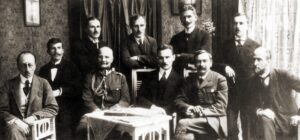 On 18 March 1921, the treaty ending the Polish-Bolshevik war (the so-called Treaty of Riga) was signed in Riga. Negotiations between Poland and Russia had been conducted since August 1920, initially in Minsk and since September in neutral Riga. In October, a decision was made to conclude an armistice. From then on, hostilities were no longer conducted. The Treaty of Riga contained a total of 26 articles. First and foremost, it defined the course of the Polish-Russian border: it ran more or less along the border of the second partition of Poland in 1793. Other provisions worth noting include the fact that Russia undertook to pay Poland compensation of 30 million roubles (which it never did) and to return works of culture, art, archives and libraries (o which only a few were returned). The treaty also laid down the rules for the return of the Polish population to the reborn country, from which about one million people benefited. Many more, around one and a half million, remained beyond our eastern border; soon, they became the first Polish victims of communist crimes, including the NKVD’s so-called “Polish operation” and the Soviet deportations of the 1930s.
On 18 March 1921, the treaty ending the Polish-Bolshevik war (the so-called Treaty of Riga) was signed in Riga. Negotiations between Poland and Russia had been conducted since August 1920, initially in Minsk and since September in neutral Riga. In October, a decision was made to conclude an armistice. From then on, hostilities were no longer conducted. The Treaty of Riga contained a total of 26 articles. First and foremost, it defined the course of the Polish-Russian border: it ran more or less along the border of the second partition of Poland in 1793. Other provisions worth noting include the fact that Russia undertook to pay Poland compensation of 30 million roubles (which it never did) and to return works of culture, art, archives and libraries (o which only a few were returned). The treaty also laid down the rules for the return of the Polish population to the reborn country, from which about one million people benefited. Many more, around one and a half million, remained beyond our eastern border; soon, they became the first Polish victims of communist crimes, including the NKVD’s so-called “Polish operation” and the Soviet deportations of the 1930s.
Photo: Polish delegation to the talks on the armistice and peace treaty with Soviet Russia, 1920. Seated from left: Władysław Kiernik, General Mieczysław Kuliński, Jan Dąbski, Stanisław Grabski, Leon Wasilewski. Standing: Michał Wichliński, Witold Kamieniecki, Norbert Barlicki, Adam Mieczkowski, Ludwik Waszkiewicz, source: Wikimedia Commons



